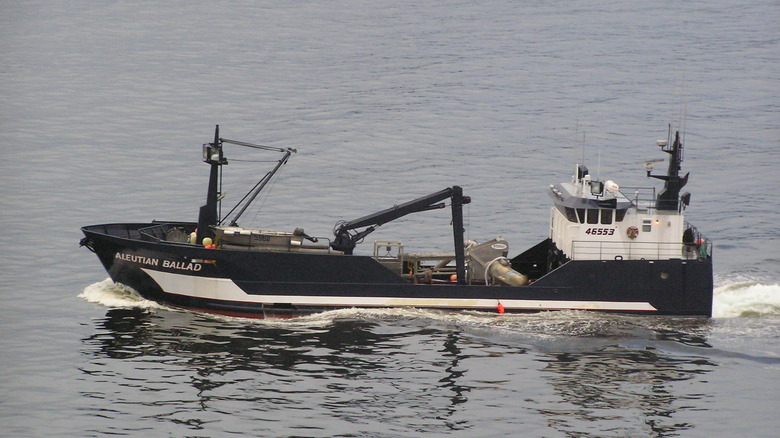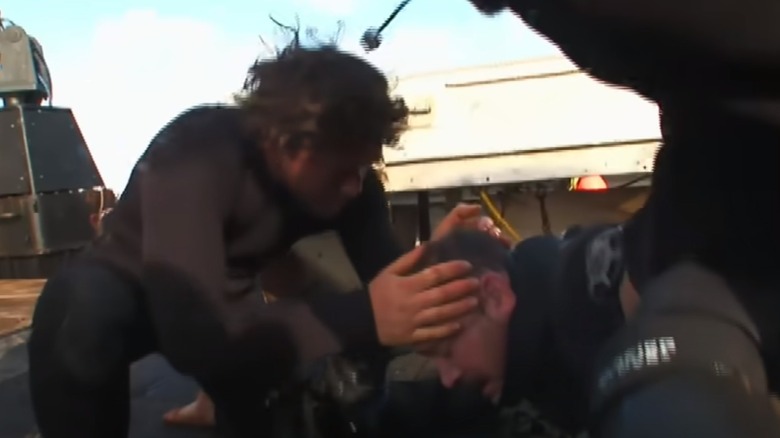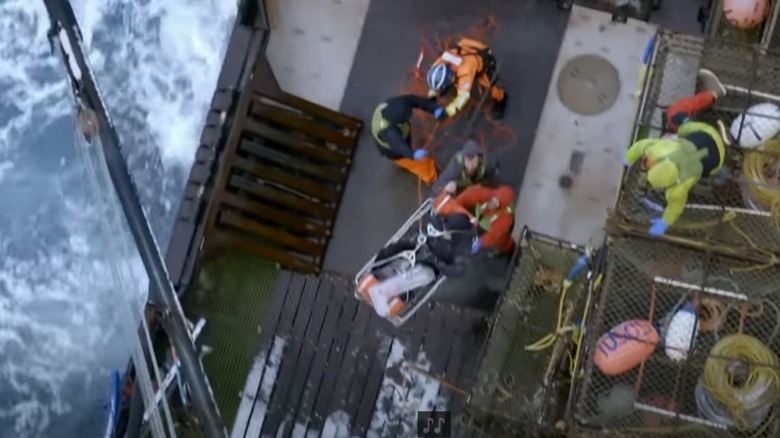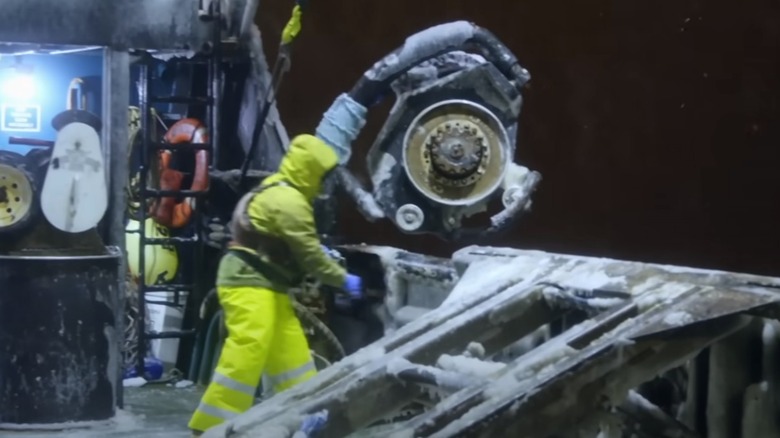The 5 Most Painful Injuries On Deadliest Catch
When your waitress delivers your steaming crab legs, you probably don't realize that the crab wasn't the only one that had to endure an arduous journey from sea to plate. Crab fishing is among one of the world's most dangerous professions. According to the Bureau of Labor Statistics, "fishing workers experience one of the highest rates of occupational fatalities." This is often due to the unpredictable nature of the sea, harsh weather conditions, and the physically demanding nature of the job. Despite these risks, the food industry remains immensely profitable and demands a steady supply of fresh seafood.
One of the most popular hubs for crab fishing is Alaska. The frigid waters off the coast of this northerly state are teeming with various crab species, including the prized Alaskan king crab and snow crab. These cold nutrient-rich waters provide an ideal habitat for crabs to thrive and grow to impressive sizes. The allure of Alaska's abundant crab populations, combined with the adrenaline-pumping challenges of fishing in its unforgiving environment, have been immortalized in popular culture by TV shows like "Deadliest Catch".
"Deadliest Catch," which began airing on the Discovery channel in 2005 chronicles the adventures of Alaskan crab fisherman, emphasizing the dangers they face. Throughout its nearly two-decade run, viewers have witnessed fishermen and crews face incredibly daunting situations. From treacherous storms to mechanical malfunctions, they have braved countless perilous situations. Among them, these are the five most painful injuries on the show.
Francis Katungin's hip and pelvis injury
A crab pot, also known as a crab trap or crab cage, is a cage-like structure designed to attract and trap crabs. They come in various sizes and weights, with the larger ones weighing several hundred pounds (via Alaskan King Crab). Getting hit by one of these hefty pots can be extremely dangerous.
Unfortunately, that's exactly what happened to Francis Katungin in April of 2022 while aboard the Patricia Lee. The ship's crew were setting their crab pots in seas that were particularly rough (though choppy waters is not uncommon in the Bering region). A large wave dislodged the pot and slammed it into Katungin so hard that he broke his hip and shattered his pelvis. He was evacuated by the U.S. Coast Guard to receive medical attention.
Bone fractures are amongst the most painful types of injuries people can suffer, and hip and pelvic fractures rank among the top 10 most painful breaks, per Movement Orthopedics. They can even be fatal and lead to complications involving the surrounding organs. In addition, because it is hard to keep these bones still, recovery is long. There haven't been major updates on Katungin's journey since the incident, but we hope that he has recovered and is well.
Schlosstein's hand and back injuries
Crab pots seem to have a vendetta against the crews on "Deadliest Catch," as evidenced by the unfortunate experiences of Roger Schlosstein aboard the Wizard. Schlosstein's ordeal began when he was handling a rope connected to an 800-pound crab pot during a fierce storm. As fate would have it, the rope slipped from his grip, resulting in a brutal impact that smashed his hand. In order to relieve him, Schlosstein was reassigned to a seemingly safer task — sorting crabs at the sorting table.
In a cruel twist of fate, another mishap occurred when a pot broke loose and propelled Schlosstein's body into the metal table. He sustained further injuries. While he miraculously avoided any fractures and breaks, he endured significant pain and trauma. His back, groin, and hand bore the brunt of the impact, leaving him incapacitated for a considerable period. Sadly, medical assistance was out of reach, leaving Schlosstein in this agonizing ordeal for some time.
Keith Colburn's skull injury
A ship's captain bears the weight of not just navigating the vessel but also ensuring its upkeep and maintenance. Captain Keith Colburn of the Wizard showcased his duty to this responsibility when the ship sustained damage to its hull. Tasked with mending the issue, Colburn plunged into the icy waters, braving the freezing temperatures. As he worked beneath the surface, his efforts were abruptly interrupted by a sudden impact. The sheer mass of the ship weighing 499 tons (per Discovery/YouTube), delivered a forceful blow to Colburn's skull. While he was able to swim back to the surface and be brought back aboard, the collision tore through his skin, leaving him disoriented and vulnerable.
Viewers witnessed the harrowing aftermath as Colburn appeared visibly shaken and rattled. It was evident he was in immense pain, exacerbated by the cold temperatures. Luckily, his crew knew what to do to prevent him from getting hypothermia, which is one of the most common ways people die while fishing and in the wilderness. Still, head injuries themselves can lead to severe complications, especially since it was clear that Colburn was bleeding. Fortunately, he seemed to recover from this incident and was able to continue with the show for the season.
Cody Rhode's leg injury
While "Deadliest Catch" showcases fishermen hauling in crabs, the show's title may inadvertently be paying a nod to crab pots which catch humans instead. In 2019, Cody Rhodes became another member of the show to have sustained an injury from a crab pot. A 1,000-pound steel crab pot collided with his leg, breaking his bones. This came after the crew had spent eight weeks on the Bering Sea, during the season finale no less. Viewers saw ghastly images of Rhodes' leg turned 90 degrees, his lower leg and ankle blue and purple from bruising.
Even the rescue mission proved dangerous as the U.S. Coast Guard had to navigate 25-knot winds and 10-foot seas to bring their chopper close enough to the ship and safely retrieve Rhodes since there was no chance he would be able to walk, let alone stand in his condition (via Discovery). Luckily, emergency responders were able to hoist Rhodes up so that he could recover in the hospital.
Taylor Jensen's multiple injuries
Aboard the Cornelia Marie, Taylor Jensen emerged as one of the unluckiest deckhands featured on "Deadliest Catch," having sustained not one, not two, but three successive injuries, each seemingly more painful than the last.
It all began with Jensen's ankle, wrenched and sprained under the force of 80,000 gallons of water during treacherous weather conditions. The force of that amount of water must have felt like a concrete wall against Jensen's body. When he thought he had endured the worst, he was dealt another blow. A crane came loose during a gusty hurricane, jostling around and leaving Jensen another victim of — you guessed it — a crab pot.
But the series of unfortunate events didn't stop there. In a freak occurrence with a coiler, his finger was torn open. Under the direction of his caption and with sheer determination, he cut off the dangling skin, wrapped up his bloodied hand, and sent back to work. Jensen's resolve to return to his duties are a stark reminder of the unforgiving nature of these crews' workplaces and a testament to the resilience required to survive in the perilous world of crab fishing.





